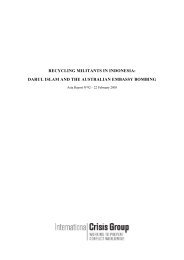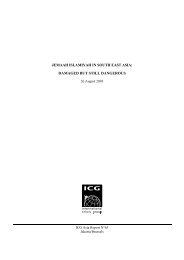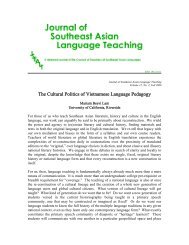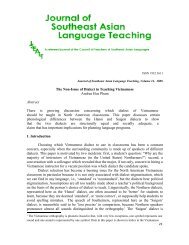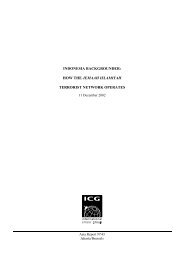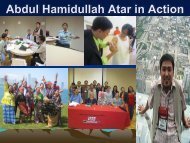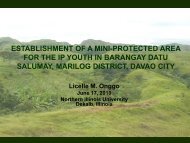Introduction - SEAsite - Northern Illinois University
Introduction - SEAsite - Northern Illinois University
Introduction - SEAsite - Northern Illinois University
Create successful ePaper yourself
Turn your PDF publications into a flip-book with our unique Google optimized e-Paper software.
Prentation Abstracts<br />
of the spectrum, Hmong Americans face with many pressing needs and issues.<br />
Some of the pressing needs and issues are family conflict, generation gap, health<br />
and mental health, poverty, and the lack of the know-how and accessibility to<br />
resources and information.<br />
This paper reviews the experience of Hmong Americans during the last 30<br />
years and list issues and problems that face Hmong Americans in 2005 and beyond.<br />
Its main emphasis is on Hmong Americans’ acculturation, education, economic<br />
and business development, political participation, and contributions.<br />
Shoua Yang<br />
The Formation and Maintenance of the Anti-Lao Government<br />
Forces<br />
Ph.D. Candidate, Department of Political Science, <strong>Northern</strong> <strong>Illinois</strong> <strong>University</strong>,<br />
<strong>Illinois</strong><br />
Although the government of the Lao People’s Democratic Republic (LPDR)<br />
claims that there is no internal conflict between the government and the resistance<br />
forces, I learned from my field research in Fresno, California, and in the Twin Cities,<br />
Minnesota, from June 2003 to December 2004 that there has been an ongoing<br />
war between the government and the resistance forces since 1975, and that the<br />
fighting still continues. Utilizing a set of open-ended questions, I interviewed 23<br />
exiled officials of the Royal Lao Government (RLG) who are cofounders, leaders,<br />
and members of the Democratic Chao Fa Party of Laos (Chao Fa) and the United<br />
Lao National Liberation Front (Neo Hom), the two affiliated homeland political<br />
organizations in America. With the help of these homeland political organizations,<br />
their affiliated resistance forces inside Laos are still actively resisting the government<br />
in the jungles of northern Laos. In April 2004, BBC journalists Ruhi Hamid<br />
and Misha Maltsev, guided by resistance secret agents, sneaked into the jungles<br />
to interview the resistance leaders. They reported to the Hmong-American, the<br />
Lao-American, and the international communities that, in fact, there is still a war<br />
between the government and the resistance forces. Thus, in contrast to the government<br />
claim, this evidence shows that there is an internal conflict in Laos.<br />
In this presentation, I will discuss the factors that led to the formation and<br />
maintenance of these two resistance forces. In 1975, the Pathet Lao seized power<br />
and adopted a persecution policy to wipe out former civilian officials and soldiers<br />
of the RLG. In counteraction, a group of former Hmong civilian officials and soldiers<br />
of the RLG reorganized themselves as Chao Fa to resist this policy. In 1978,<br />
Chao Fa was supported by Thailand; in 1979, by China; in the 1980s, by the United<br />
States. Fearful that Chao Fa, with the help of this international support, might<br />
succeed in overthrowing the Communist government of the LPDR, exiled Lao<br />
leaders and Hmong General Vang Pao formed the ULNLF/Neo Hom in 1981 to<br />
counteract Chao Fa and then the LPDR, for Vientiane, Neo Hom argues, has been<br />
dominated by Hanoi. Organizational goals, intraorganizational interaction, interorganizational<br />
networks, and honorific leadership positions essentially explain the<br />
survival of these two homeland political organizations. Having explained the leading<br />
variables in the formation and maintenance of these two homeland political<br />
organizations, I propose a conference of five members, one each from the LPDR,<br />
Chao Fa, Neo Hom, the USA, and the UN to address this Lao internal conflict.<br />
Kono Yasuyuki<br />
Lao Wisdom on Land and Forest Use: Rethinking Principles of<br />
Environmental Governance<br />
Land and water resources management, Associate Professor, Center for Southeast<br />
Asian Studies,<br />
Kyoto <strong>University</strong>, Japan<br />
Contemporary environmental policies and regulations are threatening people’s<br />
livelihood in <strong>Northern</strong> Laos, particularly of shifting cultivators. It is not solely<br />
because shifting cultivation is going to be banned. There seems to be a big gap<br />
in fundamental understanding on the concept of property right of land access to<br />
ecological resources such as land and forest. The outsiders including the government<br />
introduce simplified, mapped and fixed property right and access regulations,<br />
while people’s livelihood has been based on overlaid, temporal and spatially-buffered<br />
land and forest use. Although changes in environmental governance from an<br />
ad hoc basis to transparent ones may be a process of modernization, our experiences<br />
in the contemporary world told us that it was not always successful. Lao way<br />
of land and forest use may give us a clue to new solutions of harmonizing our life<br />
with nature.<br />
Ochiai Yukino, Ph.D.<br />
Plant Uses in Minor Subsistence of Hill Peoples: From<br />
an Ethnobotanical Aspect<br />
Ethnobotany, Associate Professor, Kagoshima <strong>University</strong> Museum, Japan<br />
In this paper, I focus on various plants used for minor subsistence of local<br />
people and suggest the role of them in people-plant relationships in mainland<br />
Southeast Asia. The various plants includes both cultivated plants like minor crops<br />
grown in home gardens and swidden fields, and wild plants like trees, grasses,<br />
herbs, climbing plants, water plants and weeds collected from different habitats<br />
like fallow lands, secondary forests, watershed, roadside and settlements. They are<br />
used for many purposes, such as for food, medicine, housing, materials, textiles,<br />
fuels, religions and rituals. Thus, people in this region still use a great diversity of<br />
plants for everyday domestic life mainly for self sufficiency, in addition to the useful<br />
plants for major subsistence, such as rice for main staple and crops and plants<br />
for cash income. Apparently, they do not have importance as the main staple and<br />
market value as the cash crops. However, even though they are not indispensable,<br />
they are still used based on personal concern and preference of local people and<br />
are kept with associated cultural practices and knowledge that evolved around it.<br />
Therefore, it can be pointed out that the various useful plants can be treated as a<br />
key factor for designing well-balanced landscape and biodiversity conservation in<br />
rural villages and also maintenance of quality of life of local people.






